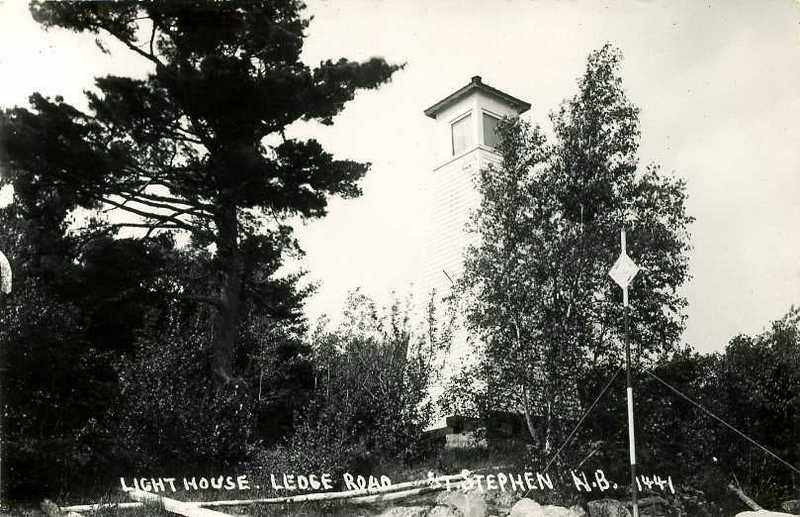
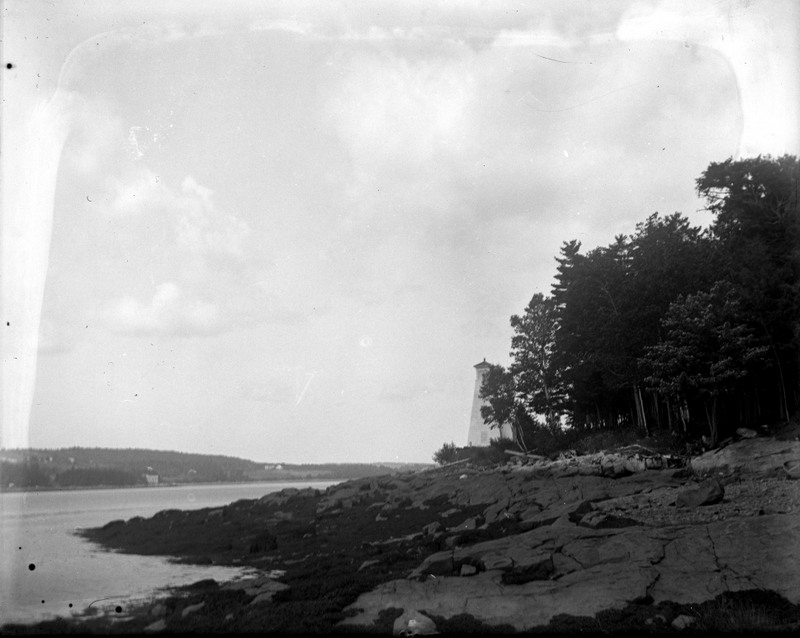
The Historical Society often receives donations of old photos and documents which folks find in the attic and we appreciate those who keep the Historical Society in mind rather than taking everything directly to the dumpster. Last week we were given a box of old documents and photos in which were several old newspaper articles that caught our eye. One written in 1950 described the heroic rescue in 1882 of two men whose boat had capsized in the St. Croix in a raging storm off Spruce Point lighthouse on the Canadian side. The rescuer was a teenage girl whose heroism was acclaimed from coast to coast. Like the author of the article we had a good deal of trouble locating Spruce Point – it doesn’t appear on today’s maps – but we did find an old article by Brand Livingstone who lived in the Stone House about five miles downriver from Calais. He knew Spruce Point well as it was within sight of the Stone House on the Canadian side between the Ledge and Todd’s Point. It is accessible from Todd’s Point road.
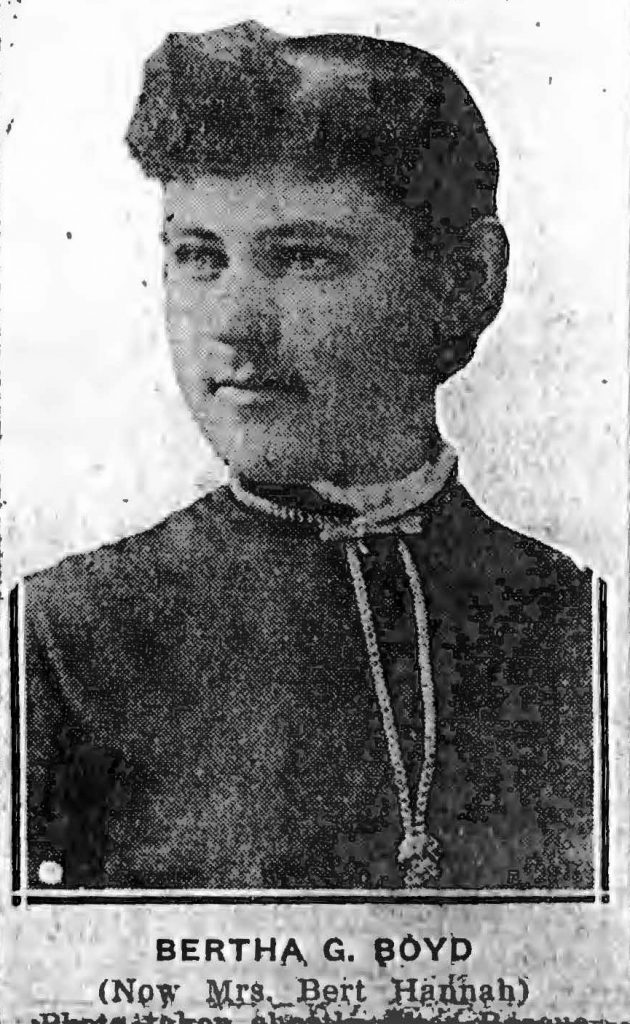
The heroine of Spruce Point was Roberta Grace Boyd, known as Berta or Bertha, it is spelled both ways in the many articles written about the rescue (and to confuse matters a bit more she married a fellow named Bert Hannah). The article we found in the recently donated documents was written by Willard De Lue in 1950. DeLue was the travel writer for the Boston Globe in the 1950’s and wrote a series of articles titled “Way Downeast With Willard De Lue”. Even in 1950 he found it quite a challenge to locate Spruce Point where he hoped to find and interview first hand sources for his article on the heroine of Spruce Point. He found her husband, Bert Hannah.
Boston Daily Globe July 17, 1950:
Roberta Boyd Spruce Point Rescue
Way Down East With Willard DeLue
Spruce Point on the St. Croix, and Its Heroine, Finally Found
ST. STEPHEN. N. B. St. Stephen isn’t what you’d call a real tourist town, even though tourists by the thousands pour through it every Summer. My own purpose in stopping here for a while was not so much to see the town, as to find Spruce Point Lighthouse. Yet. when I asked how to get to the light, not one of the first six or eight persons I talked with could tell me. “Spruce Point?” they’d say. “I never heard of it.” One man said, “Guess you mean Spruce Lake, over near St. John.” Another did some telephoning to “a man who’ll know all about it.” but who in fact did not.
“Spruce Point Light is somewhere near here on the St. Croix river,” I’d explain. When I added it was the scene of an exploit that once was known to everybody on the river, one man said he remembered hearing his mother tell about it. But he still didn’t know where Spruce Point was. Then, by merest chance, I spoke to two women down on the dock. “Why that’s our point,” said one of them; and both knew all about the lighthouse, and the story of the lightkeeper’s young daughter who became the heroine of St. Croix, and who, afterwards, was official light-keeper, and who died only a few years ago after a lifetime spent in her old home beside the river.
One threatening day in October of 1882 Roberta Grace Boyd went out from her father’s house and traveled a little pathway that leads along a high riverbank to where the lighthouse stands on a tiny point of land. Her father, Captain John Boyd was away that day; but Roberta knew the lighthouse keeper’s duties well, and she climbed the stairs to the beacon and lighted the oil lamp behind the prisms.
She was scarcely back in the shelter of the little cottage with her mother and sister when the storm broke. Black night shut down over the stream which, here a mile wide at the height of the tide, can be a grim and squally place.
“Listen!” The wind carried a faint cry. The Boyd’s rushed to the door, and there caught the cry again and again. There was trouble out there in the stormy waters.
Without hesitation, Bertha Boyd ran down the steep bank to where her father’s rowboat lay. She launched it in spite of her mother’s entreaties, and set out in it alone to battle the storm and the tumult of the river guided in the pitchy darkness by the cries of two men whose sailboat had overturned over towards the Maine shore. The story of how Berta Boyd found them there clinging in exhaustion to the rigging of their boat, of how she dragged them into her little craft, of their amazement at finding their rescuer to be a girl, and of how they all got back safely to shore all that, was told a thousand times in the homes along St. Croix in after years, and in the newspapers of the day and in the halls of government.
The Dominion presented Roberta with a fine gold watch in recognition of her heroism, and the people of St. Stephen provided a long gold chain for it. And the government gave her a splendid new boat with this inscription painted on it: Roberta Grace Boyd “Grace Darling of the St. Croix.” Grace Darling had been England’s famed young heroine of 50 years before that time. She had aided her father, the keeper at Longstone Light, in saving many lives in a shipwreck of the 1830’s. So, you see, there was a time when everybody in all New Brunswick knew where Spruce Point Lighthouse was. And surely everybody in St. Stephen must have known Berta personally. Her father died in the early 1900’s and she was appointed to succeed him. For about 40 years Roberta Grace Boyd, who eventually became Mrs. Bert Hannah, was the official lightkeeper at Spruce Point. She died in 1944 faithful to her post to the very end.
Just one block above the spot at which the tourist dashing through St. Stephen turns from the main business street along the river and heads out of town, a street runs off at the right. Its sign says “King William St.,” as I remember it- perhaps it says “Prince William.” But it really doesn’t matter, because St. Stephen calls it the “ledge” road. Those who travel it talk about going “down the ledge.” The riverbank is high and ledgy down that way.
Spruce Point lies about five miles down the ledge. “You’ll pass a school on the left, and then a church; and after that you’ll come to a school and a church right together, where there is a crossroad, the woman at the dock had told me. “Just after that there’s a fork. Bear right at the fork and you’ll get there.” And we did get there, even if the taximan admitted that Spruce Point and Spruce Point Light were new ones to him.
A sign “Hannah’s Camps,” sent us in on a little road, and soon we were parked near an old barn. The lightkeeper’s house then lay just below us, where the bank pitches to the river ledges. But there was no lighthouse in sight. Bert Hannah was there at the door, and straight as an arrow, though he admits to being 85. “When I was 65.” said he, “I played first base, and I could go through a doubleheader.” But now he uses a cane. “A while back I helped a man at haying, and I lay back on top of a high load. Next thing I knew I was in the ditch when a wheel came off the rack. Shook me up pretty bad.” he says, explaining the cane. Hannah is married again, and his wife bade a friendly welcome to the old house that Capt John Boyd occupied when the lighthouse was first built. It’s a snug and comfortable home, with the captain’s picture still hanging in the sitting room and Roberta Boyd Hannah’s portrait beside it. Since Berta’s death Bert Hannah has been the lightkeeper; and together we walked out the path to the light which the girl traveled that night of the storm.
Close to the house a brook dashes noisily down a deep ravine that cuts the riverbank. It is spanned by a long wooden footbridge which leads over to a grassy bank above the trees along the water. The path then goes along into the woods downstream, and follows the bank above the ledges to where the old lighthouse stands. It is a small lighthouse, but plenty large enough to mark the St. Croix channel turning. I climbed its tiny flights of stairs to where an oil lamp still is set in the beacon, just as it was on that night nearly 70 years ago. But other things are changed. Today a string of privately owned summer camps and cottages runs off along the bank, and the wild river of that other time is now a fair, smooth stream under a sunny sky. As we walked back to his home I asked Hannah how old Berta was at the time of her exploit. “I’ve read that she was 21,” I said. “She wasn’t that.” he said. “She was still in her teens.” And I mentioned the watch and chain and the boat. The boat has gone the way of most boats. “I sent the watch and chain, and some of the papers she had up to the museum at St. John,” said Hannah. “If you go there you’ll see them in a glass case.” So, though there are people here in St. Stephen who never heard of Hannah Grace Boyd, and who don’t know where Spruce Point Light is, it seems likely that the memory of the young heroine of the St. Croix will survive even if only among those who see her watch and chain in St. John’s New Brunswick Museum.
Delue took the time to go to the St. John museum to see the watch and chain. He wrote in an article on St. John:
“Now the museum is full of Indian relics and samples of early handicrafts and a thousand other things well worth seeing. But the things that brought me to the museum were Roberta Grace Boyd’s gold watch and chain. Possibly you read an earlier article about the young heroine of the River St. Croix who, close to 70 years ago, saved the lives of two men and was presented with a fine gold watch by the Canadian Government and a fine long chain for it by her neighbors at St. Stephen. Roberta died only a few years ago; and her husband, Bert Hannah, told me a few weeks back that he’d sent her watch and chain to the museum. “They’re in a glass case near the front door,” said he. And so they are the watch in a prettily engraved gold hunting case, the odd gold chain made up of many delicate double links. But what interested me most was the discovery that the watch had come from Massachusetts. It is a Waltham of the proud old days when Waltham was a synonym for a good watch rather than a name in the front-page news.”
Earlier accounts of the rescue were more detailed and dramatic. This from the St. Croix Courier in 1932:
When her father, John Boyd, the trusted pilot of the Bay of Fundy, left his home for a few days to be on the lookout for ships entering the Bay, leaving his young daughter, as it was his custom to do, in charge of the light, he thought little that before his return she would have performed an act of bravery which would place her in the front rank of Canadian heroines.
It was Sunday, October 8, 1882, the evening of a bleak autumnal day, the east wind presaging the coming storm, came sweeping up the broad river, and meeting the fast receding tide crested the waves with foam, that the young girl left Ravenshead cottage and hastened down the narrow path that led to the lighthouse on the Point, pausing for a moment on the little rustic bridge that spans the creek to admire the rich varied tints of the foliage brought out by the last rays of the setting sun which gilded the treetops of the precipitous cliffs around the picturesque spot. Hastening on she passed through the door of the base and ascended the steps to the tower. The great lamps were soon lighted and the steady light shone far and bright over the troubled waters. Darkness had settled upon the landscape when she returned to the cottage and was soon engaged in reading aloud with the family.
About 9 O’clock they were startled by hearing cries proceeding from the river. The cries continuing, Bertha opened the door looking downriver and soon discovered they came from persons in distress and calling loudly for help. The resolution was at once formed to go to the rescue and she called for her sister to aid her in launching the boat. The first thought of the mother was that she could not let her child face such danger alone but the brave girl was not to be deterred from her purpose saying, “suppose papa were in danger, what risk would we not take”. This was more than the mother could bear and she said “Bertie go, and may God be with you.”
The boat was soon launched and into the thick darkness shot the frail craft on its errand of mercy, but the intrepid girl, though young and slender had been trained by her father to the skillful manipulation of the oars. On she glided over the heavy swell guided only by the cries for help which were ever more despairing. A row of half a mile brought her to the scene of the overturned boat and the two men clinging to it on either side, one in the last stages of exhaustion with his head just above water, having become entangled in the ropes of the sail when the boat upset. Quickly taking in the situation and with a coolness and nerve equal to her bravery and knowing that “drowning men catch at straws” and the danger of her drowning herself with them, she placed the stern near the one least exhausted and helping him onto her boat, seized the oars and circling the upturned boat with almost superhuman effort, raised the other man over the bow, a performance that could have been accomplished in no other way even by the strongest man. She then pulled for shore guided by the light she had herself lighted but a few hours before, which as they neared and the rays fell upon them one of the almost unconscious men exclaimed, “Oh my God, we’re saved by a girl”.
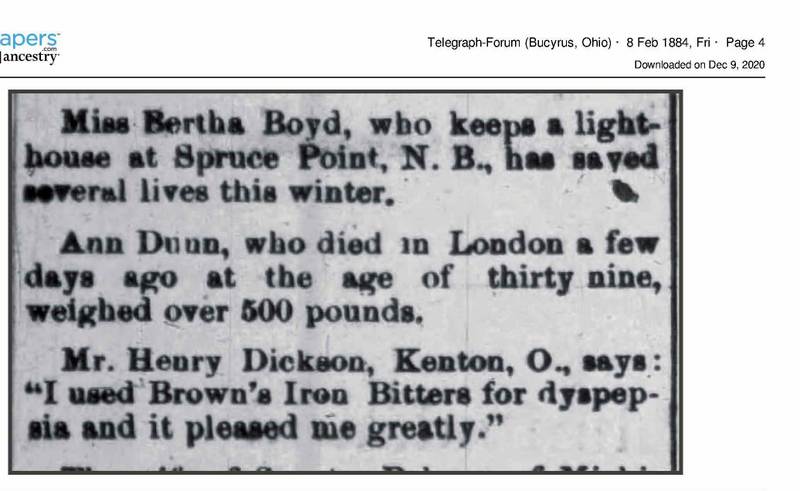
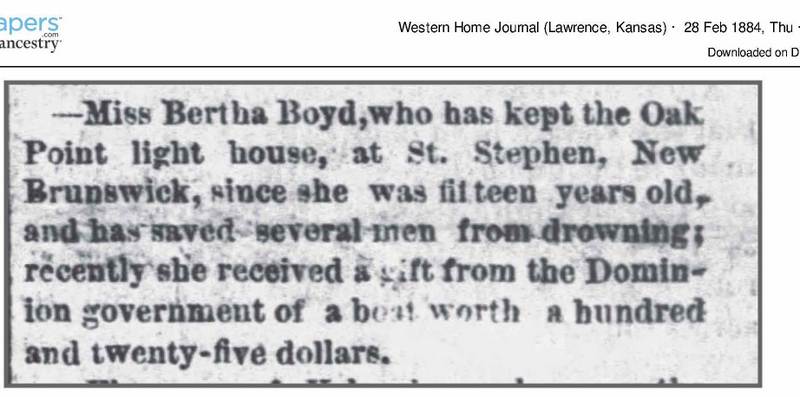
Bertha’s heroics were widely reported in the press in the United States and Canada in 1882 and two years later when she was given the new lifeboat by the Canadian government her exploits as a heroine were again reported and somewhat embellished by the press. There is no evidence she saved the lives of other reckless or unlucky mariners, although had the necessity arisen there is do doubt she would have acted just as did in 1882.
While the Spruce Point light was still standing in 1950, it has long since disappeared from the shore of St. Croix. We don’t know when this occurred but would appreciate any information, photos or other history of the light which any reader may have.
